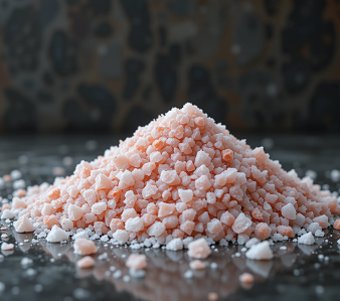What makes Himalayan salt different from regular table salt?
Himalayan salt is often considered the purest form of salt available on Earth because it is hand-mined from ancient sea salt deposits deep within the Himalayan mountains.
Himalayan pink salt gets its color from trace minerals, particularly iron oxide, also known as rust. These minerals are present in the salt deposits mined from the Salt Mine in India and Pakistan, near the Himalayas. While the salt is primarily composed of sodium chloride, like other salts, the presence of these minerals contributes to the pink hue, which can range from a light pink to a deeper, vibrant shade.
Geology of Pink Himalayan salt:
The salt deposits were formed millions of years ago when a large ocean body evaporated, leaving behind salt and other sediments. These deposits were then covered by layers of other rock and eventually pushed upwards by tectonic activity, resulting in the Salt Range mountains.
What makes Himalayan salt different from regular table salt?
Unlike regular table salt, it is free from modern environmental pollutants and does not undergo heavy processing.
Besides iron, Himalayan pink salt also contains trace amounts of other minerals like calcium, potassium, magnesium, and zinc. These minerals, along with the iron oxide, contribute to the salt’s unique color and potentially some of its taste and nutritional properties.
Himalayan salt contains up to 84 natural minerals and elements that are also found in the human body, making it more than just sodium chloride. On the other hand, regular table salt is heavily refined and “chemically cleaned,” resulting in nearly pure sodium chloride with added anti-caking agents and sometimes iodine. The refining process strips table salt of its natural minerals, leaving it a highly processed product that can disrupt the body’s natural mineral balance.
Health advantages of Himalayan salt usage over Table salt
-
Choosing Himalayan salt over table salt is often seen as a more natural and holistic option for those seeking a cleaner, more mineral-rich seasoning.
-
Rich in minerals — Himalayan salt contains trace amounts of over 80 minerals and elements that may help maintain your body’s mineral balance.
-
May improve hydration — The mineral content can support better fluid balance and help prevent dehydration.
-
Balances electrolytes — It may help restore electrolytes, supporting muscle and nerve function.
-
Supports better pH balance — Some believe it helps maintain an optimal acid-alkaline balance in the body.
-
Promotes healthier digestion — It may stimulate digestive enzymes and improve nutrient absorption.
-
Less processed — Unlike common salt, it is not chemically bleached or refined, so it retains its natural structure.
-
May aid respiratory health — Himalayan salt is often used in salt therapy (halotherapy) to help clear mucus and improve breathing.
-
Can support better sleep — Some claim it may help regulate hormones and support restful sleep.
-
Gentler on blood pressure — While still high in sodium, its mineral mix might make it slightly less taxing on blood pressure than overly processed table salt.
-
Enhances flavor naturally — Its rich, complex taste may encourage using less salt overall, potentially reducing sodium intake.
-
Its coarse crystalline structure is also favored in cooking and spa treatments for its aesthetic and therapeutic properties.
Caution to be exercised:
Despite its mineral richness, it still contains the same amount of sodium, so it should be consumed in moderation.


